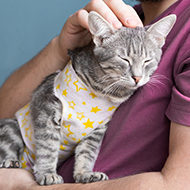Guidelines published on long-term use of NSAIDs in cats
The first version of the consensus guidelines was published in 2010.
An updated consensus guidelines for the long-term use of non-steroidal anti-inflammatory drugs (NSAIDs) in cats with chronic pain has been published.
Created by the International Society of Feline Medicine (ISFM) and the American Association of Feline Practitioners (AAFP), the guidelines are designed to support veterinary surgeons with making decisions about prescribing NSAIDs long-term to optimise pain management and minimise adverse effects.
The guidelines include information on assessing patient suitability, considerations to take into account when there are comorbidities present, and how to monitor treatment efficacy.
Alongside the guidelines, the ISFM has created three new guides for owners whose cats have been prescribed NSAIDs: ‘Treating chronic (long-lasting) pain with NSAIDs’, ‘Changes to the home environment for cats with muscle/joint pain or mobility problems’ and ‘Encouraging your cat to drink’. AAFP has also produced a client brochure: ‘Treating chronic pain with NSAIDs’, which goes alongside the guidelines.
ISFM and AAFP published the first version of their NSAID guidelines in 2010. The latest version has been informed by multiple studies into the use of NSAIDs in cats, many with a focus on cats with comorbidities, which have been published since then.
Heather O’Steen, AAFP chief executive, said: “We are thrilled to announce the release of these new guidelines addressing long-term use of NSAIDs in cats.
“With a focus on safety, efficacy, and responsible medication management, these guidelines aim to enhance the quality of life for cats while minimising potential risks. We believe that these guidelines will serve as a vital resource in ensuring the optimal care and wellbeing of cats receiving long-term NSAID therapy.”
The ‘2024 ISFM and AAFP consensus guidelines on the long-term use of NSAIDs in cats’ has been published in the Journal of Feline Medicine and Surgery.
Image © Shutterstock



 RCVS Knowledge has called on vet practices to audit their post-operative neutering outcomes.
RCVS Knowledge has called on vet practices to audit their post-operative neutering outcomes.